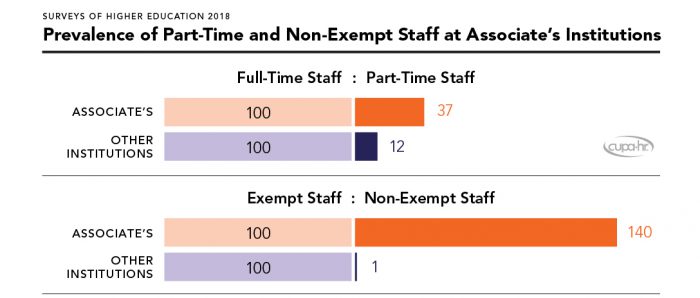A Snapshot of the Workforce at Community and Technical Colleges
Community and technical colleges serve an important role in the U.S. higher education system. They are often an option for students who need skills development or training for specific jobs in their community; who need a more affordable college option; who want to test the waters of a college education before committing to a four-year institution; or who want to take one-off courses for personal or professional development.
In an attempt to meet the needs of their unique student body and in response to the challenges they face in managing budgets cuts, managing shifting enrollments and maintaining their identity and mission, associate’s institutions differ from other institution types in the composition of their workforce, the benefits they offer, and the representation and pay of women and minorities.
CUPA-HR’s newest research brief, A Snapshot of the Staff Workforce in Community and Technical Colleges, highlights some of these differences.
Staffing at the Nation’s Community and Technical Colleges
- Associate’s institutions have a greater part-time/full-time staff ratio than do other institutions and a considerably greater non-exempt/exempt staff ratio. These differences may exist because: (a) associate’s institutions have fewer resources to devote to compensation and benefits, and/or (b) managing changes to staff numbers in response to shifts in enrollment is easier to do with part-time and non-exempt staff.

- Associate’s institutions have a lower ratio of staff to students — 5 staff for every 100 students compared to 11.6 staff for every 100 students at other institution types.
- Associate’s institutions have a proportionally greater number of HR staff compared to other institutions. Per 100 total staff, associate’s institutions have 2.2 HR staff, compared to 1.5 staff at other institutions. Additionally, the data suggests that chief HR officers at associate’s institutions have a more prominent leadership role: two out of three CHROs at associate’s institutions report to the president, compared to only one in five CHROs at other institutions types.
- Associate’s institutions have better representation of women in administrative and professional positions and better representation of minorities across all positions than do baccalaureate, master’s and doctoral institutions.
Additional Findings on Pay Equity, Benefits and Unions
- Pay for women at associate’s institutions is more equitable for administrators and professionals than at other institutions. Associate’s institutions also outperform other institutions in minority pay equity for professionals and staff.
- Associate’s institutions are less likely than other institutions to offer healthcare benefits to part-time staff and are much more likely than other institutions to offer a defined benefits plan.
- More associate’s institutions have collective bargaining for their full-time staff than do other institutions.
Read the full brief A Snapshot of the Staff Workforce in Community and Technical Colleges and CUPA-HR’s other research briefs and publications.
This brief was made possible with support from VALIC.


